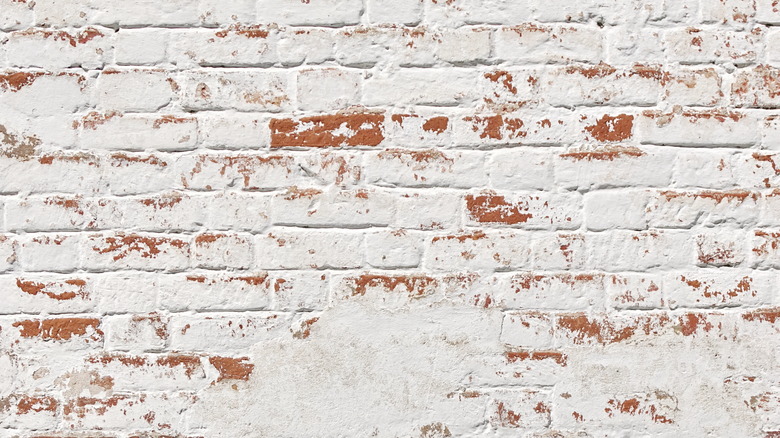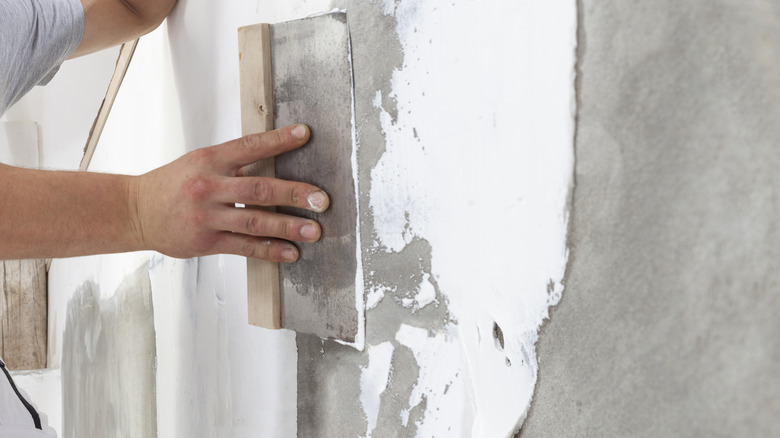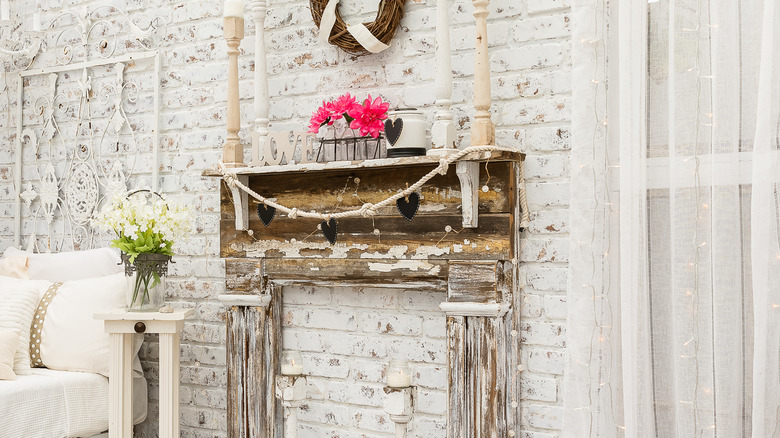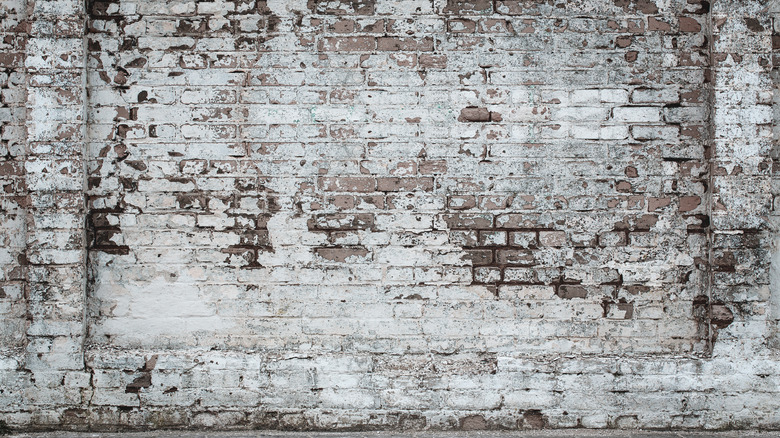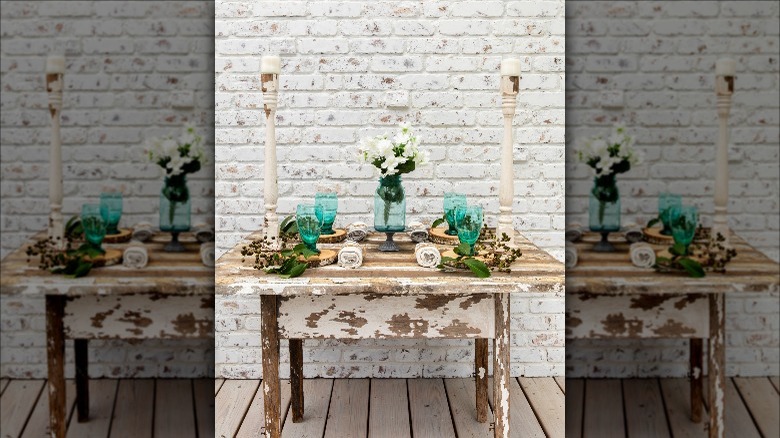What Is A German Smear, And How Can You Get The Look In Your Home?
When home prices skyrocket, many homebuyers opt for older homes instead of buying brand-new. If your home has a brick wall or fireplace, it might look worn down or outdated. Instead of spending a large amount of money to replace bricks or hire a professional to paint over them, many homeowners are opting for a stylish and affordable upgrade: German smear. Also known as German schmear, this is a mortar wash that is inexpensive and easy complete on your own, per HGTV. The end result will be a charming brick appearance that's reminiscent of old Europe.
German smear is a copycat version of irregular stones and mortar joints, a style that is regularly found on German cottages and buildings that are hundreds of years old. Instead of using paint, the process involves covering the bricks with a layer of wet mortar. The mortar dries into a rough finish, creating a distressed appearance. And, thanks to the mortar's durability, it can be used on both interior and exterior bricks.
What kind of mortar to buy
German smear can actually also be completed with tile grout, and while many people do use that, designers highly recommend using mortar. The two formulations are similar in price, but mortar is easier to adhere to the bricks and tends to yield a better result for novices. If you choose to use mortar, you have a few options. First, you can create your own mortar by mixing sand with cement, explains Renovations Roofing & Remodeling Inc. If you know a construction worker or similar tradesman with experience mixing mortar, enlist them for help. The ratio of mix to water needs to be rather precise to get the correct texture and thickness. If you're not a pro at working with these sorts of materials, consider saving yourself time and sanity by purchasing premixed mortar.
As noted on Up to Date Interiors, joint compound mortar is a breeze to use for German smear because it comes ready-made and dries white. You can expect to pay less than $20 for a bucket of joint compound. All you need besides this is a putty knife, some gloves if you wish, and a free afternoon to create a gorgeous new space.
Creating a rustic fireplace
One of the most popular uses of German smear is on fireplaces. The fireplace is a primary focal point in many homes, so it may as well have a fun look. The upside of German smear is it's easy, affordable, and relatively quick to execute, according to HGTV.
If you want to give your fireplace bricks a makeover, begin by prepping the space. Prep work is essential when it comes to German smear because it can get pretty messy. Remove any trim around the fireplace bricks and tape plastic or paper sheeting along the edges of the bricks. Next, you need to clean the bricks. It can be tempting to skip this step, but starting with clean brick will make a world of difference because the smear is white and will pick up any dirt, smudge, or imperfection. You can easily clean bricks by vacuuming or dusting them and then scrubbing them with soap and water. If you want your final product to be a brighter white, take the time to roll some brick sealant over the area and allow it to dry overnight before you begin.
Using your purchased mortar and a pastry bag, squeeze the mortar into the grout and crevice between each brick. Don't worry about overfilling. Then, take a putty knife and smear applied mortar across the bricks at a 45-degree angle. You don't need to be precise, and the end result will actually be better if you come at it from different angles. Different thicknesses throughout the brick can also affect the final look — make some areas thicker, and leave some completely bare. However you smear the mortar, the end result will be rustic and unique.
Exterior German smear
German smear is a popular look for many home exteriors. Replacing a decrepit brick exterior can be extremely expensive and requires professionals. Not everyone has a huge budget and a skilled mason on hand, making German smear attractive to those wanting to improve their home exterior for little cost. According to Bob Vila, three 80-pound bags of premixed mortar will cover about 1,000 square feet of brick siding. Premixed mortar appropriate for exteriors can be purchased for as little as $10 per bag. Compare this with $1,500-$3,000 for a professional to come to apply the smear, and you are saving a bundle.
For a small to medium-sized home, reserve at least a few days to apply the German smear. You must have bare brick to pull off this look. The smear will not adhere to painted brick.
Start the process by power-washing the bricks with water. Don't worry about any water stains on the bricks — they won't show up under the mortar. Instead, focus on removing any dirt, grease, moss, or other residue. Then, mix your mortar by combining the mix with water in a large bucket. A good rule of thumb is a ratio of 70% mortar to 30% water. It should be thick but easily spreadable, similar to the consistency of peanut butter. The thicker your formulation, the whiter and stronger the final look. The thinner your mixture, the more translucent it will appear on the bricks.
When you're ready to begin, simply spread the mortar over the bricks just as you would with an interior fireplace. One tip for exteriors: dampen the bricks before you apply the mortar. Since the formulation will dry fairly quickly and you are covering a very large area, the moisture will buy you time to go back and smooth over your work and get the exact texture and thickness you would like.
The pros and cons of German smear
As with any home improvement project, there are pros and cons to German smear, per Renovations Roofing & Remodeling Inc. It is an attractive and timeless look that is fairly easy to implement. It's one of few brick projects that are truly DIY and don't require the help of a professional. It's also very affordable compared to brick replacement or other solutions. Finally, it is extremely durable. German smear requires very little maintenance — just a simple spray down or wipe down occasionally. Other than that, German smear can be applied, finished, and left for years to come.
The downside? German smear is very permanent. If you are unsure whether or not this is the look you want, try it out on a smaller area first, or research ideas and photos online. Removing it is difficult as it requires scraping each individual brick and then using erosive chemicals that can be costly and unsafe.
